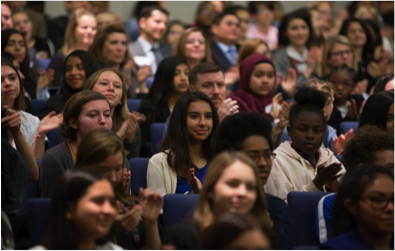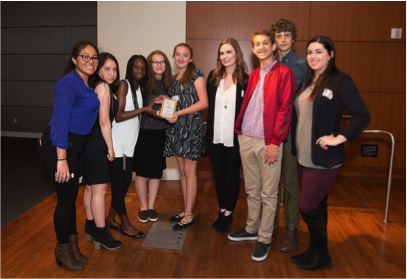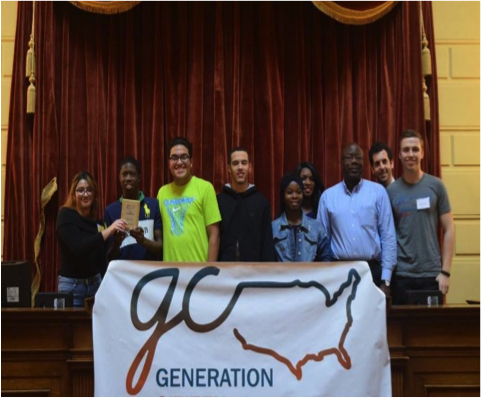Thanks to the persistence of social entrepreneurs across the country, every day we see strategies that are working and delivering results in a rapidly changing world. This Evidence in Action blog series highlights the voices of the more than 70 social innovation organizations that make up the America Forward Coalition, the results-driven solutions our community has to our country’s most pressing social problems, and the evidence-based federal programs that are critical to scaling the impact of this work. Today we will hear from Yasmine Mahdavi, America Forward Coalition organization Generation Citizen’s Measurement and Evaluation Fellow, about its model which works to ensure every student in the U.S. receives an effective action civics education, providing them with the knowledge, skills, and dispositions necessary to participate in our democracy as active and engaged citizens.

“The tyranny of a prince in an oligarchy is not so dangerous to the public welfare as the apathy of a citizen in a democracy.” – Charles de Montesquieu, French philosopher, 1734
Generation Citizen (“GC”) is a youth civics education nonprofit organization that has been in operation since 2010. We work in six states across the U.S.: Rhode Island, Massachusetts, New York, California, Texas, and Oklahoma. GC’s program is a semester-long action civics project implemented in middle- and high-schools in partnership with college student volunteer democracy coaches and classroom teachers, where students learn civics through taking collective action on a local community issue. The curriculum is aligned with relevant local and state standards.
Our mission is to ensure that every student in the U.S. receives an effective action civics education, which provides them with the knowledge, skills, and dispositions necessary to participate in our democracy as active and engaged citizens. As such, we teach and inspire students to identify and understand a community issue and its root causes, think strategically and deliberately about how to alleviate the problem, and effect change through interacting with local decision makers, influencing legislation or other means.
Action Civics Projects from Around the Country: Qualitative Assessment of Classroom Learning
At the end of the semester, on “Civics Day”, students present their action plans and preliminary outcomes to public officials, fellow GC classes, and other community members. Project topics range from bullying in school and teenage homelessness to domestic abuse and police violence. Judges for this civics fair have included governors, commissioners of education, and members of Congress.
We have identified two priorities for our students’ learning in constructing civically effective projects: (1) intent: to pursue more politically specific goals by targeting governmental and other systems of power to achieve systemic solutions and (2) purpose: to interact more with community stakeholders and decision-makers beyond the classrooms. Over the years, we have witnessed a significant shift in the quality of projects as a result, and the stories below demonstrate this inspiring development in 2016-2017 academic year.
Brooklyn middle-school students were frustrated that healthy food was not affordable in their neighborhood and acted to increase the availability of nutritious foods at their school. To achieve this goal, students advocated in support of a City Council bill that would require school cafeterias to publicize their health inspection scores.
 With much uncertainty surrounding immigration deportation in the community, students in San Francisco collaborated with their school’s Director of Enrollment and teachers to create a safe space for undocumented and immigrant students and their families. They wrote letters to Gateway administrators calling for an official statement from the principal in students’ information packets. The class also pushed for administrators to develop an ICE emergency plan and a “know your rights” information session for students.
With much uncertainty surrounding immigration deportation in the community, students in San Francisco collaborated with their school’s Director of Enrollment and teachers to create a safe space for undocumented and immigrant students and their families. They wrote letters to Gateway administrators calling for an official statement from the principal in students’ information packets. The class also pushed for administrators to develop an ICE emergency plan and a “know your rights” information session for students.
In Bastrop (Texas) students found there were limited activities available for 14-16-year-olds in their town after school hours. To ensure that youth were considered in the creation of city-wide programming, the students advocated for the creation of a City Youth Advisory Council. After researching Youth Advisory Councils in nearby towns, students reached out to similar groups across Texas, getting input from local city managers, other Youth Advisory Councils, and Parks and Recreation departments to draft a proposal. Students presented their findings to the City Manager and City Council where their plan was ultimately approved.

These students elegantly and thoughtfully demonstrated how to address the challenges they and their communities face. While in the program they explored meaningful civics issues and learned how to be active and engaged citizens with agency. At Generation Citizen, we believe that age is not, and should not be, a barrier to civic engagement. All of us can and should contribute to the betterment of our society.
To date, GC has served more than 30,000 students. Last year, our teachers reported 72% of students participating in the program improved their civic knowledge and 70% increased their civic skills. Seventy-five percent of students believed they had the power to make a difference in the community. However, to continue to replicate and scale GC’s Action Civics programs, sufficient funding is required. While historically civics education funding has not been prioritized by the federal government, we are grateful to have seen the appropriation of the new American History and Civics Education National Activities Grant, which was authorized under the recently-passed ESSA bill. We hope that funding and prioritization of this support for innovative civics education programs continue to grow.
This post is part of America Forward’s Evidence in Action blog series. Follow along on Twitter with #EvidenceinAction and catch up on the series here.
One Response to “Evidence in Action: Age is Not a Barrier to Civic Engagement”
Leave a Reply
You must be logged in to post a comment.